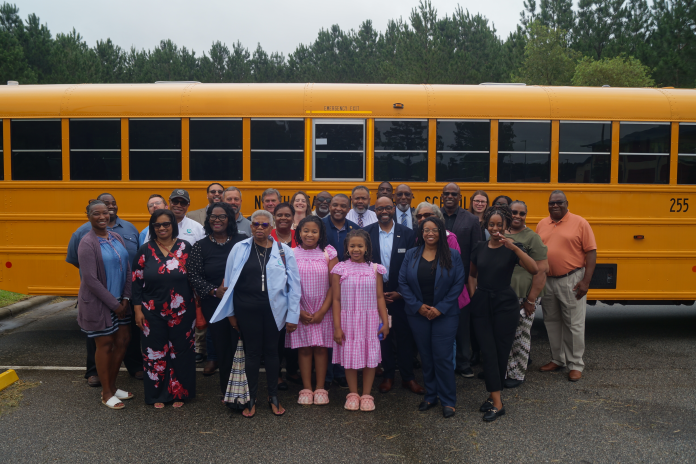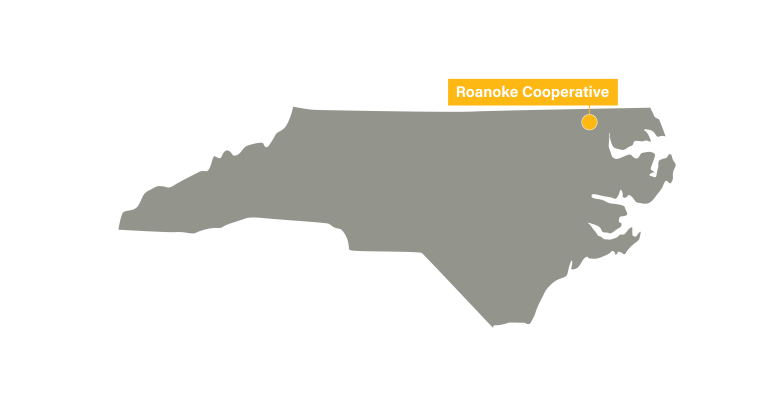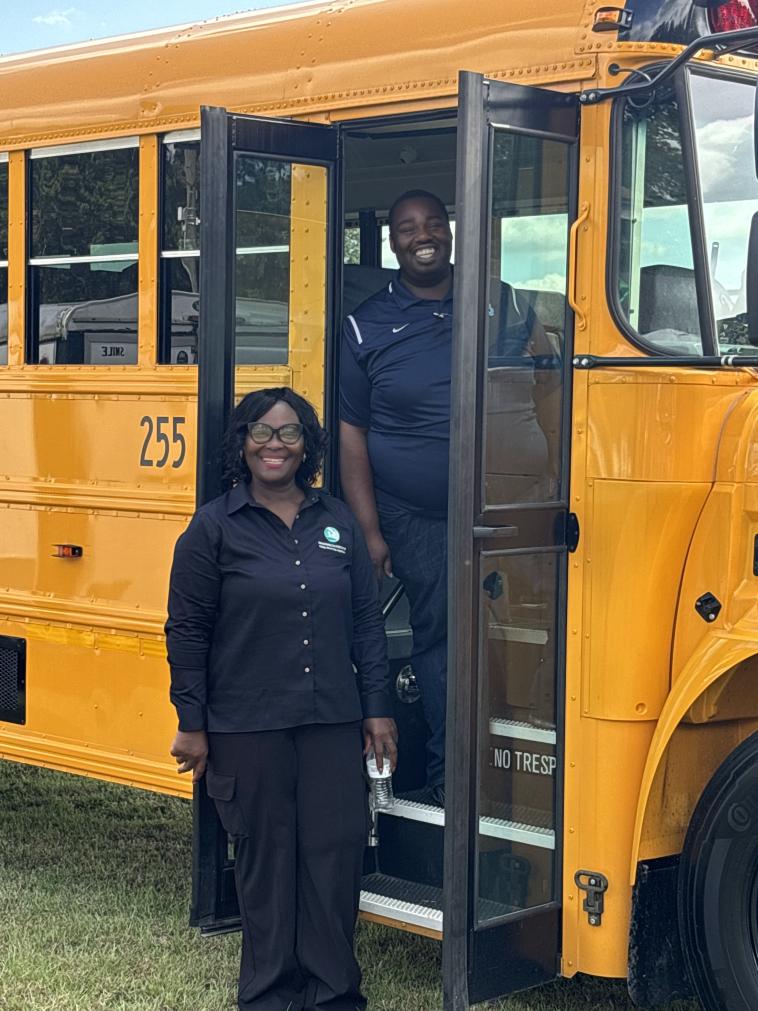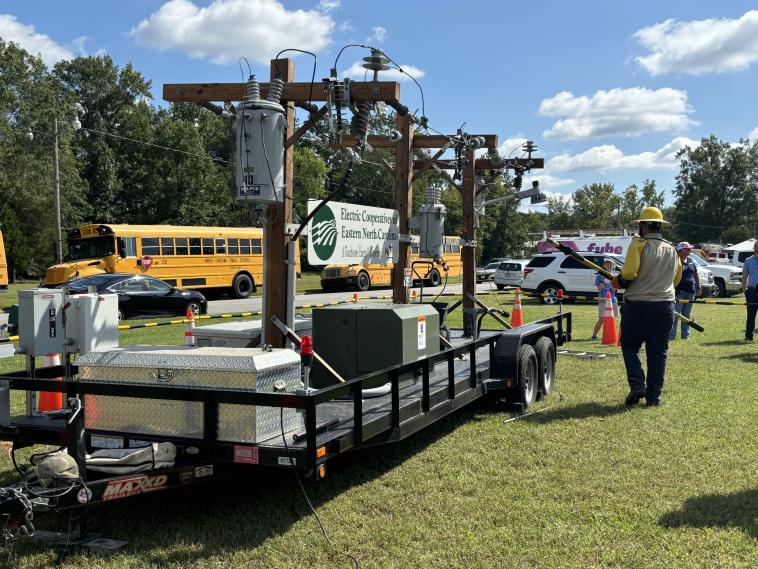How a Rural North Carolina Electric Cooperative Brought Electric School Buses to Historically Underserved Communities
Roanoke Cooperative is revolutionizing the role of rural electric cooperatives by paving the way for electric school buses in rural North Carolina, delivering benefits to students and community members.

When school districts first begin considering electric school buses for their fleet, it is important that they reach out to their electric utility. But in northeastern North Carolina, it was the local electric cooperative that first brought the idea of electric school buses to the districts in its region.
Roanoke Cooperative is working to transform the role of electric utilities in school transportation by leading the way in local school bus electrification.
| Roanoke Cooperative | |
|---|---|
| Location | Hertford County, North Carolina |
| Number of school districts | 7 school districts |
| Number of electric school buses currently operating in fleet | 5 electric school buses |
Roanoke Cooperative serves six school districts and one charter school and primarily operates in a low-income, rural area with a majority Black population.
The Cooperative’s members prioritize positive health outcomes, and when the leadership looked for opportunities to advance this mission, the health benefits of clean and reliable electric school buses stood out.
“We had the electric buses [at Clean Energy Expo] for all of them to ride, and who would’ve thought that grown people were clamoring to get on the electric bus?”- Angella Dunston, Roanoke Cooperative’s Public Relations & Engagement Coordinator
What is an electric cooperative?
Rural electric cooperatives are member-owned nonprofit utilities that serve rural communities throughout the U.S. These cooperatives are co-owned by their members who take part in the planning process through the local organization’s board, differing from an investor-owned utility that is regulated by the state and returns profits to its shareholders.
These cooperatives were initially created in part due to the 1936 Rural Electrification Act, through which rural communities secured funding for electric distribution systems and established the cooperative electric utility system.
Battling a history of underinvestment
Roanoke Cooperative serves about 12,000 individuals through 14,000 electricity meters spanning agricultural industries and rural communities. With a density of 6 meters per square mile, the cooperative serves a sparsely populated region, presenting unique infrastructure challenges.
In this part of North Carolina, a history of underinvestment means communities and local children are already facing significant environmental health challenges like air pollution and flooding, according to Angella Dunston, Roanoke Cooperative’s Public Relations & Engagement Coordinator.

“When you talk about the challenges of living in an impoverished area, in that type of environment, anything that we can do to help our member-owners offset the other challenges that they may face: breathing clean air, having access to healthy food … when you don’t have transportation and you can’t get to a doctor, helping them to be able to access technology to be able to do a telehealth visit,” Dunston said.
As part of its broader mission to support the health and environment of its area, Roanoke Cooperative has expanded telehealth services in its area, worked to expand broadband access, and collaborated with agricultural cooperative members to create solar and battery storage programs.
Now, Roanoke Cooperative is turning its attention to electric school buses.
“A 100% fleet of electric school buses is the sign to me, and that’s something that I could see take place in the near future.” - Basil Williams, Roanoke Cooperative’s Senior Manager of Member Services & Public Relations
Roanoke Cooperative’s journey to electric school buses
For children in rural areas, longer transportation routes mean that clean transportation options are essential for reducing exposure to diesel emissions and improving air quality.
This effort began when the cooperative’s leadership reached out to the local school districts for proactive conversations about introducing electric school buses. In these discussions, Roanoke Cooperative and the schools worked to establish a real partnership that would continue throughout the process.

Roanoke Cooperative collaborated closely with school districts, state leadership and community partners to gauge interest in transitioning to electric school buses. Once school districts displayed interest, the cooperative held monthly meetings with school district leadership to ensure the alignment of funding mechanisms, environmental impacts and costs savings.
This partnership continued as the cooperative played a key role in assisting districts with grant applications for the EPA’s Clean School Bus Program (CSBP) — funding that helped make the electric school bus vision a reality.
Two school districts in Roanoke Electric’s area received CSBP funding through the 2023 CSBP rebate and grant programs. Halifax County School District received funding for four electric school buses, while Bertie County Schools was awarded funding for five electric school buses.
Both school districts have been pleased with the range and performance of the electric school buses, and Roanoke Cooperative plans to bring more electric school buses to districts in its area.
The partnership between the school districts and the cooperative wasn’t the only key collaboration in this effort. Roanoke Cooperative also worked closely with the North Carolina Department of Environmental Quality’s Air Quality Division to better understand the environmental impacts of electric school buses. And, recognizing the importance of meaningful community engagement, Roanoke Cooperative sought input from parents, local governments and health foundations to build widespread support.

The cooperative established a Roundtable Advisory Committee to engage cooperative members in the decision-making process of transitioning to electric school buses. It also conducted social media outreach to share information around how funding originated and highlight the benefits of electric school buses.
While assisting with the transition to electric school buses has ultimately been a success for Roanoke Cooperative, there were initial infrastructure concerns and challenges with administrative bandwidth. But through technical assistance programs and transparent communication, Roanoke Cooperative was able to mitigate these challenges successfully. Additionally, through regular meetings with key stakeholders, the cooperative was able to address concerns about electric school buses and build trust with the community.
What’s the latest?
The school districts deployed the new electric school buses smoothly; in one county, an electric school bus is running the longest route in the service area and experiencing no issues with range. Roanoke Cooperative hasn’t had any concerns with charging capacity for the buses. Basil Williams, the cooperative’s Senior Manager of Member Services & Public Relations, aims to further local electrification with an “impact study to make distribution upgrades to accommodate additional chargers.”
Roanoke Cooperative’s efforts to transition to electric school buses have been met with broad community support, according to Dunston and Williams. This support was garnered through community events and educational opportunities. Roanoke Cooperative celebrated the launch of electric school buses and chargers with events featuring congressional representatives, parents, students and local leaders.
The community has also participated in electric vehicle technology educational opportunities like a Clean Energy Expo, where the cooperative showcased electric school buses and local businesses to center clean energy.
It was at events like this that Dunston saw firsthand how excited community members were for electric school buses.
“We had the electric buses for all of them to ride, and who would’ve thought that grown people were clamoring to get on the electric bus?” she said.
Students also had the opportunity to attend a STEAM camp sponsored by the cooperative. Over the course of a week, students explored science, technology, engineering, agriculture and math while utilizing the electric school buses in their educational activities. The cooperative is also assisting school districts in developing a hands-on class to teach students how to build an electric vehicle.

Advice for others
Roanoke Cooperative offers three key pieces of advice to other cooperatives looking to help school districts in their service area transition to electric school buses.
- Involve stakeholders early. By bringing parents, school leaders and local government officials to the table early, Roanoke Cooperative built trust and long-term support for the project.
- Actively educate the community. By highlighting the financial and health benefits of electric school buses, Roanoke Cooperative was able to foster enthusiasm for the project.
- Look to implement the project at scale. Starting with a smaller fleet allows for manageable deployment while establishing infrastructure for future expansion.
Roanoke Cooperative’s role in the transition to electric school buses exemplifies how rural communities can lead the way in sustainability and equity. By combining innovative solutions with community-centered advocacy, the cooperative is paving the way for a cleaner, healthier future for its children.
As for the future of Roanoke Cooperative’s initiative to transition to electric school buses, Williams says he wants a 100% electric fleet for the area’s school buses and notes “that’s something that I could see take place in the near future.”